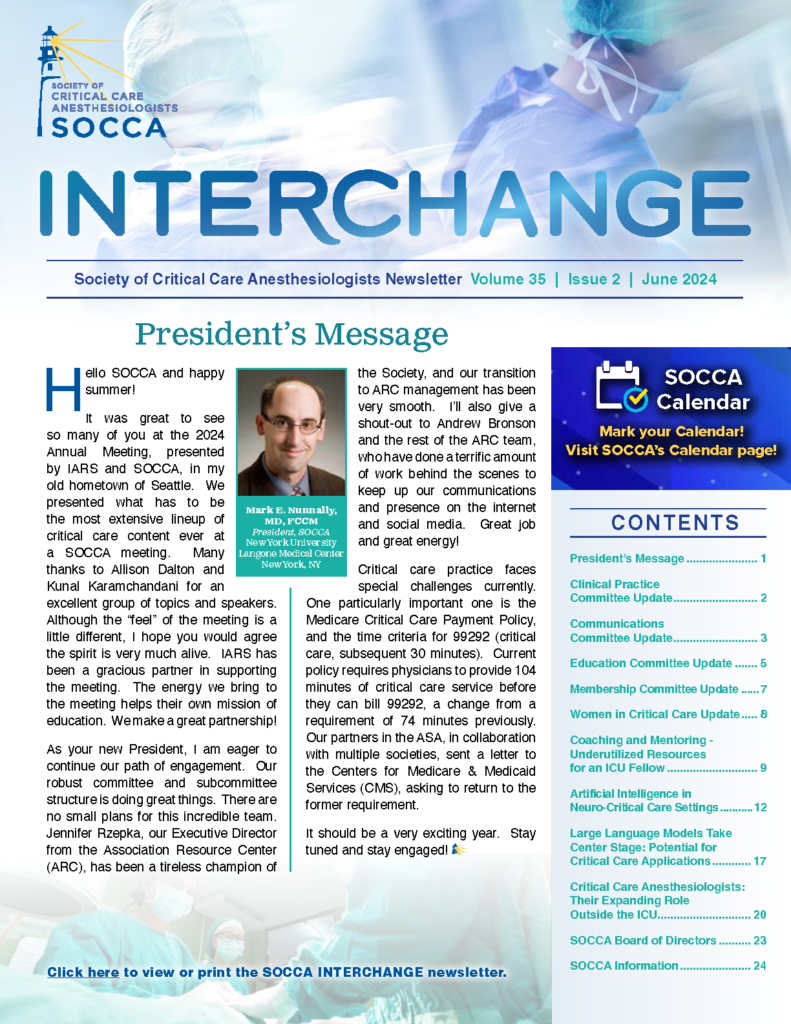Women in Critical Care: Where We Are & Where We Want to Be
Where We Are
Over the past decade, the need to promote gender diversity in medicine has been embraced by several medical societies. In the USA in 2017, 33% of critical care trainees and 26% of ICU physicians were women. There are many reasons for this disparity and work is being done to understand these reasons to some extent. It was noted in literature that an explicit focus on “eliminating gender inequity will help to gradually change societal views of the roles played by women and men critical care physicians so that it will become the norm for women and men to be both critical care physicians and leaders in critical care.”
In 2018 SOCCA leadership held a facilitated Strategic Planning retreat. At that time, it was recognized that SOCCA could do better in terms of diversity and inclusion. Leadership and administration noted that there was a need to address this better within the SOCCA bylaws, mission statement and strategic planning. These underwent major enhancements with this in mind. Women Directors on the Board increased threefold from two to six from 2017 to 2022.
In 2018 SOCCA added two additional seats on the Board of Directors to work on increasing diversity of the SOCCA Board. In addition, a set of guidelines was created to encourage diverse members to apply (https://socca.org/wp-content/uploads/2021/01/Criteria-for-SOCCA-Volunteer-Leadership.pdf). Within the Board, both the Secretary and Treasurer are women, in line for future further leadership roles.
SOCCA currently has four committees, with two led by women (Education and Membership committees). There are two new working groups (Women in Critical Care and Early Career Intensivists) both envisioned and led by women. Training and mentorship programs for women and men intensivists have been developed within all committees to enable equitable promotion of women to higher academic ranks, gain research opportunities and leadership positions.
Where We Want to Be
Seeing how SOCCA has evolved, these efforts have been associated with considerable improvement in this arena. In the words of one past President, “We need to maintain focus and continue to track how the Society evolves but I think we have a strong foundation to further build upon.”
There is still a long way to go to address the reasons of disparate numbers of women joining critical care anesthesiology and assuming roles in leadership and research roles. It is not enough to believe that women may choose not to achieve the same metrics of success as men do, due to personal or life factors. Perhaps these metrics need reimagination and reinvention, with greater support and sponsorship from both men and women who have achieved these accolades. Flexible scheduling, and promotion criteria, accommodation of mid-career or older women to achieve research mentorship, funding and research or educational tracks, (so they can balance childbearing and relationship responsibilities with academic roles, and not have to sacrifice either one in order to be judged successful) are examples of such ‘out of the box’ viewpoints.
The Women in Critical Care group is aiming to launch several initiatives in social media outreach, networking, motivational talks, podcasts for the busy woman intensivist to watch at a convenient time (aimed at work and life aspects), webinars (on wellness and other topics) and a white paper on suggestions and input from stakeholders on how societies and organizations can move forward with gender diversity.
We will need support and involvement from within and outside SOCCA to make these initiatives a success.




































